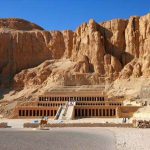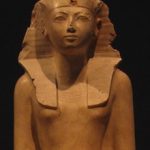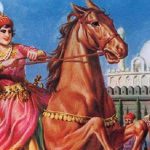Hello and welcome! Here we are at Episode 3 and we are very glad to have you join us! I will be honest and say i wrote the blog for Episode 4 first so sorry for the little delay on this. Enjoy!
- Temple of Hatshepsut at Dayr al-Baḥrī, Thebes, Egypt.
- Statue of Hatshepsut on display at the Metropolitan Museum of Art
- The Hawk of the Pharaoh, Hatshepsut—Temple at Luxor
Name: Hatshepsut
Born: 1508 BCE Died: 1458 BCE
What they did: First women to obtain full role as Pharaoh, was a really good one too.
Facts:
- Hatshepsut was the longest reigning female pharaoh in Egypt, ruling for 20 years in the 15th century B.C. She is considered one of Egypt’s most successful pharaohs.
- Hatshepsut was the elder of two daughters born to Thutmose I and his queen, Ahmes.
- After her father’s death, 12-year-old Hatshepsut became queen of Egypt when she married her half-brother Thutmose II, around 1492 B.C.
- Thutmose II died after a 15 year reign, making Hatshepsut a widow before the age of 30 and the throne went to his infant son, also born to a secondary wife (Isis). According to custom, Hatshepsut began acting as Thutmose III’s regent, handling affairs of state until her stepson came of age.
- After less than seven years, however, she claimed the role of pharaoh.
- Thutmose III was never deposed of and was considered co-ruler throughout her life, but it is clear that Hatshepsut was the principal ruler in power.
- Hatshepsut fought to defend her legitimacy to the throne, pointing to her royal lineage and claiming that her father had appointed her his successor.
- She ordered that she be portrayed as a male pharaoh, with a beard and large muscles.
- This was not an attempt to trick people into thinking she was male; rather, since there were no words or images to portray a woman with this status, it was a way of asserting her authority.
- Hatshepsut’s successful transition from queen to pharaoh was, in part, due to her ability to recruit influential supporters.
- Under Hatshepsut’s reign, Egypt prospered. Unlike other rulers in her dynasty, she was more interested in ensuring economic prosperity and building and restoring monuments throughout Egypt and Nubia than in conquering new lands.
- She built many great temples including Deir el-Bahri, (considered one of the architectural wonders of ancient Egypt) and Djeser-djeseru (“holiest of holy places”). She also erected a pair of red granite obelisks at the Temple of Amon at Karnak, one of which still stands today.
- Another great achievement of in the ninth year of her reign was a trading expedition she authorized that brought back vast riches–including ivory, ebony, gold, leopard skins and incense–to Egypt from a distant land known as Punt (possibly modern-day Eritrea).
- The queen died in early February of 1458 B.C. when she would have been in her mid-40s.
- She was buried in the Valley of the Kings, located in the hills behind Deir el-Bahri and she had her father’s sarcophagus reburied in her tomb so they could lie together in death.
- Late in his reign, Thutmose III began a campaign to eradicate Hatshepsut’s memory: He destroyed or defaced her monuments, erased many of her inscriptions and constructed a wall around her obelisks. As a consequence, scholars of ancient Egypt knew little of Hatshepsut’s existence until 1822, when they were able to decode and read the hieroglyphics on the walls of Deir el-Bahri.
- Portrait of Razia Sultan
- Coin of Razia Sultan. Source Wikimedia Commons
- Artist’s rendition of Razia Sultan
Name: Razia al-Din
Born: 1205 Died: 1240
What they did: The first and only woman ruler of Delhi.
Facts:
- Razia was born to Shams-ud-din Iltutmish, a former Turk slave and Qutb Begum (the Sultan of Dehli’s only daughter), they also had a son, Nasiruddin Mahmud.
- Razia had a privileged upbringing. She was close to high ranking members of
the court and harem. - She was the favorite of her father and her maternal grandfather (the Sultan). Contrary wise, her half-brothers Rukn ud-din Firuz and Muiz ud-din Bahram, who were children of former slave girls, werenot favored and grew up away from the centers of power.
- When Razia was 5 years old, the sultan Qutb ud-din Aibak died. Her father succeeded him, becoming Sultan.
- She was trained to administer a kingdom, in the event her father or husband were absent.
- Despite Razia’s abilities, intelligence, and royal lineage, her brother, Nasiruddin, was groomed to succeed Iltutmish instead. However, Nasiruddin suddenly died in 1229.
- Iltutmish made Razia his heiress apparent (making him the first Sultan to do so) after she was ruler of the city in his absence when he went away for war for a year.
- Unfortunately for Razia, after her father’s death in 1236, her half-brother, Rukn ascended the throne instead.
- His mother basically ruled for him allowing him to do as he pleased. She had a penchant for executing people had wronged her and both she and her son were quickly removed from power (6 month reign).
- Reluctantly, the nobility agreed to allow Razia to finally reign as Sultan of Delhi under the official name, Jalâlat-ud-Dîn Raziyâ, This made her the first and only woman ruler of Delhi.
- As part of her becoming a ruler, Razia gave up purdah, which is the practice of living in a separate room or dressing in all-enveloping clothes in order to stay out of sight of men or strangers. She instead opted to dress similarly to the male rulers before her which was a shocking move in a conservative Muslim
society. - During her reign, she acted as chief of the army and even rode an elephant to lead her forces into battle. She captured new territories and expanded her kingdom.
- Razia was not just a competent warrior; she also worked to strengthen her kingdom by encouraging trade, strengthening the infrastructure, and establishing proper laws.
- Razia eventually married childhood friend and Governor of Bathinda, Malik Ikhtiar-ud-din Altunia, but how they got there is something terrible.
- He had long hoped to be her royal consort, but Razia’s responsibilities as Sultana took priority, so she
continuously turned down his marriage proposals. - After Malik became governor, Razia relied on a slave named Jamaluddin Yaqut, causing his status to quickly skyrocket from “Lord of the Stables” to “Chief of the Nobles.”
- There were rumors, that Razia and Yaqut were in a relationship.
- Malik (being jealous we assume) lead a rebellion against Razia.
- During the rebellion Yaqut was killed and Razia was captured by Malik.
- While in prison in Bathinda, it’s said she was treated well because Malik was in love with her. Eventually, Razia was released and she and Malik were married.
- While Razia was imprisoned, her other half-brother, Muiz (MUZE) proclaimed himself king, backed by 40 chiefs.
- Razia, with the help of Malik, tried to regain power, assembling their forces and marching towards Delhi.
- They were defeated by Muiz, deserted by their remaining forces, and fled Delhi to Kaithal.
- They day after their defeat, on October 14th , 1240, they were both killed.
- Razia’s reign lasted only 4 years. She was 35.
- Razia’s burial site is disputed and is said to be in one of three places:
- A courtyard in Bulbul-i-Kahn near Turkmen Gate, Delhi. Part of the tomb has been converted into a mosque.
- Kaithal
- Tonk, Rajasthan, where it’s said she is buried with Yaqut.
- She has honorary tombs in all three places.







Pingback: The Dinner Party – Wing One Prehistory to Classical Rome – Wining About Herstory